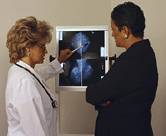
MONDAY, Dec. 7 (HealthDay News) — Better screening, healthier living and new treatments have all continued to help cut the annual number of cancer cases and deaths in the United States, a new report says.
The findings showed that new cancer cases and deaths from cancer have declined significantly for both men and women and for most racial/ethnic populations.
These decreases were largely due to decreased incidence and death from lung, prostate and colon cancer among men and a drop in two of the three leading cancers in women (breast and colon cancers). New diagnoses for all types of cancer in the United States declined almost 1 percent per year from 1999 to 2006 and cancer deaths dropped 1.6 percent per year from 2001 to 2006.
The report, which appears in the Dec. 7 online edition of Cancer, was compiled from data by the American Cancer Society, the U.S. Centers for Disease Control and Prevention, the U.S. National Cancer Institute and the North American Association of Central Cancer Registries.
“For me, when I see the downturn in some cancers it says we can actually address the cancer burden through a variety of efforts,” said report author Brenda K. Edwards, associate director of the Surveillance Research Program at the U.S. National Cancer Institute.
But the battle against cancer continues, she stressed. “We see the downturn in mortality, but we still have almost 1.5 million people with new cancer diagnoses in 2009. So, we still have a large number of people affected. For some of them, we have relatively effective treatments and for others not so.”
Edwards noted that for the cancers that have seen the biggest decreases, such as breast and colon cancer, effective screening methods probably explain the downward trend, although there are still too few people who take advantage of them.
Cancer rates are still higher for men than for women, but men had the biggest declines in new cases and death, the report showed.
This year’s report focused on trends in colorectal cancer. Colorectal cancer, the third most-diagnosed cancer in both men and women, is also the second-leading cause of cancer deaths in the United States. Overall, colon cancer rates are declining, but the decline is mostly among those over 65. Increasing numbers of cases in men and women under 50 is worrisome, the report noted.
Among both men and women, there were major declines in colorectal cancer cases from 1985 to 1995, minor increases from 1995 to 1998, and significant declines from 1998 to 2006. Since 1984, death rates also dropped, with accelerated rates of decline since 2002 for men and since 2001 for women.
In fact, from 1975 to 2000, cases of colorectal cancer fell 22 percent; 50 percent of which was most likely due to changes in lifestyle, and 50 percent to more people being screened.
In addition, deaths from colorectal cancer fell 26 percent during the same time; 9 percent of the drop came from lifestyle changes, 14 percent came from screening and 3 percent came from improved treatment, according to the report.
Going forward, if there were no changes in lifestyle, screening or treatment, there would be a 17 percent drop in colorectal cancer deaths from 2000 to 2020. However, if current trends remain the same, there will be a 36 percent drop in colorectal cancer deaths.
But, if more Americans adopted more healthy lifestyles, such as quitting smoking, and were screened for colon cancer and had access to optimal treatment (such as more effective chemotherapy), deaths from colon cancer could be reduced by 50 percent by 2020, the report predicted.
Other highlights from the report were that among men, cases of prostate, lung, oral cavity, stomach, brain, colon and rectum cancers have declined, but cases of kidney/renal, liver and esophageal cancer, along with leukemia, myeloma and melanoma, are increasing.
Among women, cases of breast, colorectal, uterine, ovarian, cervical and oral cavity cancers decreased, but cases of lung, thyroid, pancreatic, bladder and kidney cancers, along with non-Hodgkin lymphoma, melanoma and leukemia are on the rise.
Where cancers have increased, Edwards noted that in most cases there are no effective screening tests to catch the cancer early. In addition, for many of these cancers, the causes aren’t known and there aren’t effective treatments, she said.
Cancer death rates remain highest among blacks and lowest among Asian/Pacific Islanders. Although death rates by race/ethnicity were similar for most cancers, deaths from pancreatic cancer, the fourth most common cause of cancer death in the United States, increased in white men and women but dropped among black men and women.
Among men, except for Asian/Pacific Islanders, the three leading causes of cancer death were lung, prostate and colorectal cancer. Among Asian/Pacific Islanders, lung, liver and colorectal cancers were the top three causes of cancer death.
For women, except Hispanic women, the three leading causes of cancer death were lung, breast and colorectal cancer. For Hispanic women, breast cancer was the leading cause of cancer deaths, the study authors noted.
These differences in death rates may be due to differences in risk behaviors, socioeconomic status and access to and use of screening and treatment, according to the report.
While these trends are expected to continue, they could be accelerated if more people would make the lifestyle changes needed to reduce their risk of cancer. These include not smoking, maintaining a healthy weight, eating a healthful diet and exercising.
In addition, lives could be saved if more people were screened for cancers such as breast and colon cancer, and if there was more access to newer treatments, the report said.
Dr. David L. Katz, director of the Prevention Research Center at Yale University School of Medicine, said that “there is enormous detail in this comprehensive report, but the take-away message is as clear as it is compelling: the incidence and death toll from cancer are both steadily, if gradually, declining.”
That is not a new message, Katz noted.
“The gratifying conclusion is that we are effectively fighting cancer at every level: preventing it outright by modifying cancer risk factors; finding it early through effective screening; and treating it ever more effectively. The benefits of screening suggested here are timely in light of recent debate about the net benefits of mammography,” he said. “The overall news here is clearly good, and is something of a rebuke for those who fear modern science rather than embracing the benefits it so often confers.”
More information
For more information on cancer, visit the American Cancer Society.

